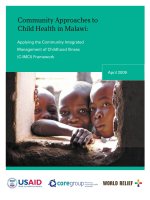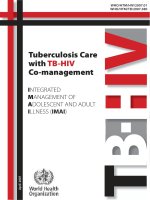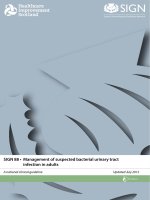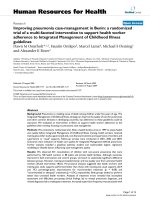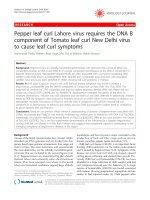Integrated management of chilli leaf curl disease complex in Ranchi region in Jharkhand, India
Bạn đang xem bản rút gọn của tài liệu. Xem và tải ngay bản đầy đủ của tài liệu tại đây (224.15 KB, 9 trang )
Int.J.Curr.Microbiol.App.Sci (2019) 8(1): 945-953
International Journal of Current Microbiology and Applied Sciences
ISSN: 2319-7706 Volume 8 Number 01 (2019)
Journal homepage:
Original Research Article
/>
Integrated Management of Chilli Leaf Curl Disease Complex in
Ranchi Region in Jharkhand, India
N. Zeeshan and N. Kudada*
Department of Plant Pathology, Faculty of Agriculture, Birsa Agricultural University,
Ranchi, Jharkhand, India
*Corresponding author
ABSTRACT
Keywords
Chilli, Chilli leaf
curl, Integrated
management, Fruit
yield
Article Info
Accepted:
10 December 2018
Available Online:
10 January 2019
Chilli is an economically important and widely cultivated crop of India. Chilli leaf curl
disease complex is one of the major limiting factors in chilli production which is
drastically decrease yield. The crop grown in Jharkhand usually suffers seriously from this
disease. A field experiment on integration of insecticides as soil application with one
and/or two sprayings each of other insecticides viz. Imidacloprid 17.8% SL @ 0.003%,
Spinosad 45 % SC@160 ml/ha and neem products viz., Neem Seed Kernel extract (NSKE
5%) @ 5ml/ litre and Neem oil 0.03 % @5ml/litre was carried out during Rabi 2015-16
cropping season. Integration of soil application of Carbofuran 3G @ 30 Kg/ha plus two
sprays of Imidacloprid 17.8% SL@ 0.003% recorded minimum disease incidence
(12.58%), highest green fruit yield of 101.56 q/ha and maximum disease reduction
(61.12%) and considerably enhanced plant vigour and green fruit yield of chilli. Maximum
disease incidence (32.35%) was observed in control with lowest yield of 57.56 q/ha.
Highest cost-benefit ratio of 1:3.60 was obtained by soil application of Carbofuran 3G @
30Kg/ha plus two sprays with Imidacloprid 17.8% SL @ 0.003%. Chilli leaf disease
complex adversely affected yield attributing characters during Rabi cropping season.
Introduction
Chilli (Capsicum annuum L.) is considered as
one of the most important vegetable and
commercial spice crops grown throughout
warm temperate, tropical and subtropical
regions of the World. Chilli also called red
pepper belongs to the genus Capsicum under
the Solanaceae family. Besides traditional use
of chilli as vegetables, spices, condiments,
sauces and pickles, it is also being used in
pharmaceuticals, cosmetics and beverages
(Tiwary et al., 2005). In Jharkhand, it is grown
mostly in the districts of Ranchi, Hazaribag,
Palamu and Giridih etc. Although there is a
scope to enhance the productivity of chilli, a
number of limiting factors have been
attributed to the productivity. The damage
caused by insect pests and mite is of
paramount importance. The chilli leaf curl is
most severe in India because of its complex
nature. Virus diseases like mosaic and leaf
curl complex caused heavy losses (Singh et
al., 1998). Venkatesh et al., (1998) reported
945
Int.J.Curr.Microbiol.App.Sci (2019) 8(1): 945-953
that chilli leaf curl complex was caused by
chilli leaf curl geminivirus (CLCV)
transmitted by white fly (Bemisia tabaci) also
by thrips (Scirtothrips dorsalis) and mites
(Polyphagotarsonemous latus). These are the
major insects which besides sucking the sap of
the plant parts, also act as vectors. Senanayake
et al., (2006) reported that a very high disease
incidence (upto 100% plants during
December, 2004) in farmers’ fields in Narwa
and Tinwari villages at Jodhpur district,
Rajasthan was observed. Overuse of pesticides
has been often leading to the development of
undesirable problems like destruction of
natural enemies. It is essential to manage the
vectors in an integrated manner in which
botanicals and insecticides play an integral
part and becoming more relevant in the
present-day disease management scenario.
Chilli leaf curl disease complex causes huge
crop losses in Jharkhand state primarily due to
attack of thrips, mites and white fly followed
by invasion of chilli leaf curl virus.
Considering the importance of the disease and
losses, the present study was, therefore,
undertaken to integrate insecticides and
botanicals for the management of vector
activities for reducing chilli leaf curl disease
incidence in Ranchi region of Jharkhand.
Materials and Methods
To determine the efficacy of different
insecticides and plant products on the
incidence of leaf curl disease incidence fruit
yield and yield attributing characters a field
trial was conducted during Rabi, 2015-2016
cropping season in the glasshouse compound,
Department of Plant Pathology, Birsa
Agricultural University, Ranchi, Jharkhand,
India. Field experiments were conducted in
Randomised Block Design (RBD) with three
replications and seven treatments. The trial
was conducted during Rabi, 2015-16 cropping
season by using the variety G-4. Thirty five
days old seedlings were transplanted in 3 m x
1.5 m sized plot with 50 cm x 50 cm spacing.
Soil application of Carbofuran 3G @ 30 Kg/ha
was applied after 35 days of transplanting.
After ten days of soil application of
Carbofuran 3G @ 30 Kg/ha sprayings were
done by insecticides and plant products.
Control plots were maintained without soil
application of Carbofuran. The required
concentration of all the insecticides, plant
products were spraying two times. The details
of treatments were as follows:T1-Soil
application of Carbofuran 3G @ 30 Kg/ha
plus two sprays with Spinosad 45% SC, T2Soil application of Carbofuran 3G @ 30 Kg/ha
plus two sprays with Imidacloprid 17.8% SL
@0.003%, T3-Soil application of Carbofuran
3G@ 30 Kg/ha plus first spray with Spinosad
45%SC@ 160ml/ha plus second spray with
Imidacloprid 17.8% SL @ 0.003%,T4-Soil
application of Carbofuran 3G @ 30 Kg/ha
plus two sprays with Need Seed Kernel
Extract
(NSKE)
5%
@5ml/lit,T5-Soil
application of Carbofuran 3G @ 30 Kg/ha
plus two sprays with Neem oil 0.03%
@5ml/lit.,T6- Soil application of Carbofuran
3G @ 30 Kg/ha plus first spray with NSKE
5%@5ml/lit. plus second spray with Neem oil
0.03%@5ml/lit, T7–Control. The Disease
incidence was recorded at frequent intervals
after the appearance of disease symptoms. The
percent disease incidence was recorded by
counting the number of diseased plants in each
treatment. Fruit yield was recorded from each
treatment then it was converted into q/ha.
Yield attributing characters were recorded at
maturity stage of crop. Disease incidence was
observed in each plot by counting total
number of plants as well as diseased plants.
Percent disease incidence was calculated by
following formula suggested by Nene (1972):
% Disease Incidence =
No. of Diseased units
x 100
Total no. of assessed units
946
Int.J.Curr.Microbiol.App.Sci (2019) 8(1): 945-953
Percent disease reduction was calculated by
following formula:
each replication of each treatment at maturity
stage of crop.
Percent disease reduction =
Results and Discussion
C─T
A field trial was carried out during Rabi,
2015-16 cropping season to determine the
effect of integration of insecticides and
botanicals against chilli leaf curl disease
complex. All the treatments differed
significantly when compared with control. The
disease incidence was reduced by all the
treatments in combination. Minimum disease
incidence (12.58 percent) as recorded by the
treatment T2 (Soil application of Carbofuran
3G @30kg/ha plus 2 sprays of Imidacloprid
17.8% SL @0.003%) and maximum yield of
101.56 q/ha which was statistically at par with
treatment T3 (Soil application of Carbofuran
3G @30kg/ha plus 1st spray with Spinosad
45% SC @160ml/ha plus 2nd spray with
imidacloprid
17.8%
%)which
recorded disease incidence of 14.64 percent.
Maximum disease incidence 32.35 percent
was recorded in control with lowest yield of
57.56 q/ha. The treatment T2 (Soil application
of Carbofuran 3G @30kg/ha plus 2 sprays of
Imidacloprid 17.8% SL @0.003%) recorded
maximum disease reduction over control
(61.12 percent) which was statistically
superior to all other treatments followed by
T3(Soil application of Carbofuran 3G
@30kg/ha plus 1st spray with Spinosad 45%
SC @160ml/ha plus 2nd spray with
imidacloprid
17.8%
%)(54.75
percent). The increase in yield over control
was highest in T2 (76.44 percent) followed by
T3 (68.73 percent) and T1 (61.38 percent)
(Table 1 and Fig. 1).
x 100
C
Where, C is Percent disease incidence in
untreated plants,
T is Percent disease incidence in treated
plants.
The per cent increase of yield in treatment
over control was calculated from the following
formula (Vanisree et al., 2013).
Per cent increase of yield in treatment over
control=
Yield in treatment ─Yield in control
Yield in control
The fruit yield was recorded during the entire
crop season and converted to per hectare.
Yield was estimated after final picking of
fruits. Cost - benefit ratio was calculated by
using formula as follows:
Cost - benefit ratio =
Net profit (Rs.)
Cost of application
Net Profit = Value of additional yield over
control (Rs.) – Cost of application (Rs)
Following yield attributing characters were
recorded as follows: 1. Plant height (cm), 2.
No. of branches/plant (no.), 3. Fruit length
(cm), 4. Fruit breadth (cm), 5. Fruit weight
(gm). Yield attributing characters were
recorded from randomly selected five plants in
Highest cost-benefit ratio of 1:3.60 was
obtained when soil application of Carbofuran
3G @ 30 kg/ha plus two sprays of
Imidacloprid 17.8% @0.003 percent (T2) was
applied. This T2 treatment also recorded net
return of Rs. 34438 /- which was statistically
947
Int.J.Curr.Microbiol.App.Sci (2019) 8(1): 945-953
superior to all other treatments followed by T3
(soil application of Carbofuran 3G @ 30
kg/haplus first spraywithSpinosad 45% SC
@160 ml/ha plus second spray with
Imidacloprid 17.8% %) (1:2.82).
The lowest cost-benefit ratio (1:1.35) was
recorded by soil application Carbofuran 3G
@30kg/ha plus 1st spay with NSKE 5%@
5ml/lit. plussecond spray with neem oil5%
@5ml/l. (T5) (Table 2).
During Rabi, 2015-16 cropping season
maximum mean plant height (39.87), mean
no. of branches/ plant (5.7), mean length/fruit
(6.21cm), mean breadth/ fruit (0.98 cm) and
weight/ plant (44.92 gm)were recorded in
treatment T2 (soil application of Carbofuran
3G @ 30 kg/ha plus two sprays of
Imidacloprid 17.8% percent)
which was followed T3 (soil application of
Carbofuran 3G @ 30 kg/ha plus first spray of
Spinosad 45%SC @160 ml/ha plus second
spray of Imidacloprid 17.8% SL @ 0.003%).
All the treatments were found to be
statistically superior over control (Table 3).
Since, Imidacloprid is a new molecule hence
no literature is available for supporting to
results. The next effective treatments were T3
followed by T1 and T4.
Table.1 Integrated disease management of leaf curl disease and green fruit yield of chilli
Rabi, 2015-16 cropping season
Treatments
Dose
Leaf curl
disease
incidence
(%)
Disease
reduction
over
control
(%)
46.99
Yield
(q/ha)
Increase
yield over
control
(%)
92.89
61.38
T1-
Soil application of Carbofuran 3G
plustwo sprays ofspinosad 45% SC
30kg/ha +
160ml/ha
17.15
(24.44)**
T2-
Soil application of Carbofuran 3G
plus two sprays ofImidacloprid
17.8% SL
Soil application of Carbofuran 3G
plus 1st spray withspinosad 45%SC
plus 2nd spraywith Imidacloprid
17.8% SL
Soil application of Carbofuran 3G
plus two sprays with NSKE 5%
Soil application of Carbofuran 3G
plus two sprays with Neem oil
0.03%
Soil application of Carbofuran 3G
plus 1st spray with NSKE 5% plus
2nd spray with Neem oil 0.03%
Control
30 Kg/ha +
0.003 %
12.58
(20.69)
61.12
101.56
76.44
30kg/ha +
160ml/ha+
0.003%
14.64
(22.48)
54.75
97.12
68.73
30 Kg/ha +
5ml/lit
18.58
(25.47)
42.56
90.00
56.36
30 Kg/ha+
5ml/lit
21.86
(27.84)
32.43
93.56
62.54
30 Kg/ha +
5ml/lit
19.02
(25.71)
41.20
88.89
54.43
T3 -
T4T5-
T6-
T7-
S.E.m ±
C.D. at 5%
C.V. %
** Figures in parentheses are arcsine transformed values
948
32.35
(34.64)
1.07
3.32
7.13
57.56
0.364
1.135
15.81
Int.J.Curr.Microbiol.App.Sci (2019) 8(1): 945-953
Table.2 Cost-benefit ratio of integrated disease management
Treatments
T1-
T2-
T 3-
T4-
T5-
T6-
Soil application of
Carbofuran 3G plus
two sprays with
spinosad 45% SC
Soil application of
Carbofuran 3G plus
two sprays wit
Imidacloprid
17.8%SL
Soil application of
Carbofuran 3G plus
1st spray spinosad
45%SC plus
2ndspray
imidacloprid 17.8%
SL
Soil application of
Carbofuran 3G
plus two sprays
with NSKE 5%
Soil application of
Carbofuran 3G plus
two sprays with
Neem oil 0.03%
Soil application of
Carbofuran
3G
plus 1st spraywith
NSKE 5% plus 2nd
spray with Neem oil
0.03%
Control
T7S.E m±
C.D. at 5%
C.V. %
Rabi, 2015-16 cropping season
Value of
Cost of
Net
Cost
additional insecticidal return/ benefit
Yield @ application
ha
ratio
Rs 1000/q
(Rs)
(Rs)
(Rs)
35330
11130
24200 01:2.17
Dose
Yield(q/
ha)
30kg/ha
+
160ml/ha
92.89
Additional
yield over
control
(q/ha)
35.33
30
Kg/ha+
0.003%
101.56
44.00
44000
9562
34438
01:3.60
30kg/ha
+
160ml/ha
+
0.003%
97.12
39.56
39560
10346
29214
01:2.82
30
Kg/ha+
5ml/lit
90.00
32.44
32440
12960
19480
01:1.50
30Kg/ha
+
5ml/lit
93.56
36
36000
13650
22350
01:1.64
30
Kg/ha+
5ml/lit
88.89
31.33
31330
13305
18025
01:1.35
57.56
0.364
1.135
15.81
-
-
-
-
-
Rate: Spinosad-Rs 210/-, Imidacloprid –Rs 140/-, Carbofuran 3G-Rs 90/-, Neem oil-Rs70/,NSKE 5%-Rs 240/-,
Labour cost- Rs225/-, Three Applications:- 1st application- Soil application of Carbofuran 3G2nd and 3rdapplicationSprayingwith insecticides and plant products, Rate of green fruit/Kg –Rs 100/-
949
Int.J.Curr.Microbiol.App.Sci (2019) 8(1): 945-953
Table.3 Effect of integrated management on yield attributing characters of chilli
Treatments
T1-
T2-
T 3-
T4-
T5-
T6-
Soil application of
Carbofuran 3G plus
two sprays with
spinosad 45% SC
Soil application of
Carbofuran 3G plus
two sprays wit
Imidacloprid 17.8%SL
Soil application of
Carbofuran 3G plus
1st spray spinosad
45%SC + 2ndspray
imidacloprid 17.8% SL
Soil application of
Carbofuran 3G
plustwo spray with
NSKE 5%
Soil application of
Carbofuran 3Gplus
two spray with Neem
oil 0.03%
Soil application of
Carbofuran 3G plus
1st spray with NSKE
5% plus 2nd spray with
Neem oil 0.03%
Control
T7S.Em±
C.D. at 5%
C.V. %
Dose
Mean
plant
height
(cm)
37.89
Rabi,2015-16cropping season
Mean no. of
Mean
Mean
Mean
branches/pl length/fruit breadth/
fruit
ant
(cm)
fruit
Weigh/
(No.)
(cm)
Plant
(gm)
5.00
6.12
0.74
44.45
30kg/ha +
160ml/ha
39.87
5.70
6.21
0.98
44.92
39.67
5.36
6.19
0.75
44.84
37.77
4.65
5.78
0.74
40.15
34.66
4.33
4.76
0.72
39.75
36.99
4.43
5.38
0.71
39.29
32.25
1.54
4.84
7.27
3.90
0.34
1.07
12.54
4.39
0.35
1.21
12.34
0.45
0.08
0.25
18.33
33.81
2.06
6.43
8.72
30 Kg/ha+
0.003 %
30kg/ha +
160ml/ha
+
0.003%
30 Kg/ha+
5ml/lit
30Kg/ha+
5ml/lit
30 Kg/ha+
5ml/lit
950
Int.J.Curr.Microbiol.App.Sci (2019) 8(1): 945-953
Fig.1 Integrated disease management of chilli leaf curl disease and green fruit yield of chilli
Rabi (2015-16) season
Effect of integrated management on incidence
of leaf curl virus disease and fruit yield of
chilli was studied by using different
insecticides and neem products viz., soil
application of Carbofuran 3GImidacloprid
17.8% SL, Spinosad 45% SC, NSKE 5%,and
Neem oil 0.03%. Among these combinations
of Carbofuran 3G @30 Kg/ha as soil
application plus two sprays with Imidacloprid
17.8% SL @ 0.003% recorded minimum
mean disease incidence of 12.58% and
highest mean fruit yield of 101.56 q/ha.
Maximum disease reduction over control
(61.12%)was observed by one times soil
application of Carbofuran 3G @ 30 Kg/ha
plus two sprays of Imidacloprid 17.8%SL @
0.003%.It also recorded highest increase in
yield over control (76.44%). Combination of
Soil application of Carbofuran 3G plus NSKE
and combination of Carbofuran 3G plus
Neem oil gave poor results as compared to
combination of insecticides. Considering costbenefit ratio, higher cost-benefit ratio of 1:3.6
was obtained by soil application of
Carbofuran 3G plus two sprays with
Imidacloprid followed by soil application of
Carbofuran plus first spray with Spinosad
plus second spray with Imidacloprid which
observed cost-benefit ratio of 1:2.82.
Maximum mean plant height, number of
branches per plant, fruit length, fruit breadth,
fruit weight was recorded by soil application
of Carbofuran 3G plus two sprays with
Imidacloprid. These phenotypic characters
were statistically significant in all the
treatments. These results are similar with
report of earlier several workers. Mallapur
(2004) reported maximum dry chilli yield in
GCK (garlic chilli kerosene) extract +
951
Int.J.Curr.Microbiol.App.Sci (2019) 8(1): 945-953
Nimbicidine treated plots. Thus, the results
were clearly emphasizing the possibility of
reducing pesticide load in the pest ridden crop
like chilli. These practices also promise
production of pesticide - free chilli, which is a
major deterrent in the international market.
Rajasri et al., (1991) evaluated six synthetic
insecticide, four neem preparations and one
chitin inhibitor as foliar spray against chilli
pests complex including mite, P. latus under
field conditions in Andhra Pradesh during
1989 and found chitin inhibitors, dulhar least
effective against P.latus. Triazophos proved
the best among the synthetics, whereas neem
preparations gave poor results as compared to
synthetic insecticides. Results on the
effectiveness of neem based treatments on the
management of P. latus in red chilli revealed
that all the integrated treatments, without or
with the inclusion or one spray of
phosphamidon at 45 days after transplanting
(DAT) were highly effective and safe to
natural enemies (Chakraborti, 2000). Of the
important components of IPM for vegetable
production (Rai and Singh, 2008) pesticide
application is one. In a field trial during
summer in West Bengal, detopping of
affected shoots at 16 DAT followed by
application of neem cake 1kg /m2 at 20-days
interval or foliar application of neem oil (10
ml/litre)+ Azadiractin(4ml/litre) at 7 DAT and
need based application of Profenofos
(2ml/litre) effectively controlled mites and
thrips on chilli and were quite safe to natural
enemies (Chakraborti, 2004). Neem products
controlled the pest chilli thrips (Scirothrips
dossalis Hood) effectively (Keisa and
Varatharanjan, 1995). Sprays of Imidacloprid
200 SL (0.5ml/l) mixed with neem oil or P.
pinnata oil (0.2%) were more effective
(Sidhu, 2008).
compared to control. Therefore, the
investigation strongly recommends the soil
application of Carbofuran 3G 30kg/ha @plus
two sprays with Imidacloprid17.8 % SL @
0.003% against the vector activities to reduce
chilli leaf curl disease complex.
Acknowledgement
The authors are highly grateful to the
Department of Plant Pathology, Birsa
Agricultural University, Ranchi, Jharkhand
for providing the necessary facilities during
the course of study.
References
Chakraborti, S. (2000). Neem based
integrated schedule for the control of
vectors causing apical leaf curling in
chilli. Pest Mngt. Econ.Zoolo.8 (1): 7984.
Chakraborty,
S.
(2004).
Sustainable
management of apical leaf culing in
chilli. J. Appl.Zoo. Res. 15 (1): 34-36.
Keisa, J. T. and Varatharajan, R. (1995).
Efficacy of two neem products in the
field control of Scirtothrips dorsalis
Hood (Thysanoptera) on Capsicum
annum. Indian J. Plant Prot. 23: 166168.
Mallapur, C.P. (2004). Management of chilli
pests through indigenous materials.
Karnataka Journal of Agricultural
Sciences, 17 (2): 315-319.
Nene, Y.L. (1972). A survey of viral diseases
of pulse crops in Uttar Pradesh. G.B.
Pant. Univ. Agric. Technol. Pantnagar
Res.Bull., 4, 911.
Rai, S. N. and Singh. (2008). Efficacy of
some Acaricides/ Insecticides against
Tetranychus urticae Koch. on Okra.
Indian journal of Entomology, 70(2):
169-171.
Rajasri, M., Reddy, G.P.V., Krishnmurthy, M.
and Prasad, V.D. (1991). Bioefficacy of
In conclusion, it was apparent from the effect
of integration of insecticides with plant
products in field condition that integration
effectively reduced the disease incidence as
952
Int.J.Curr.Microbiol.App.Sci (2019) 8(1): 945-953
certain newer insecticides and neem
products against chilli pest complex.
Indian J. Cocoa Arecanut Spices,
15:42-44.
Senanayake, D. M. J. B., B. Mandal, S. Lodha
and A. Verma, A. (2006). First report of
chillileaf curl affecting chilli in India. J.
Food Agric. Environ., 4: 171-174.
Sidhu, A.S. (2008). Annual Report 20082009, Indian Institute of Horticultural
Research, Hessarghatta, Banglore.
Singh, R. P., Devakumar, C. and Dhingra, S.
(1988). Activity of neem (Azadirachta
indica A. Juss.) seed kernel extracts
against
the
mustard
aphid,
Lipaphiserysimi. Phytoparasitica, 16:
225-230.
Vanisree, K., Upendhar, S., Rajasekhar, P.,
Ramachandra Rao, G. and Srinivasa
Rao, V. (2013). Field evaluation of
certain newer insecticides against chilli
thrips, Scirtithrips dorsalis (Hood).
Science Park Research Journal, 1(20):
1-13.
Venkatesh, H.M., Muniappa, V., Ravi, K.S.
and
Prasad,
K.
P.R.
(1998).
Management of chilli leaf curl complex.
In: Advances in IPM for horticultural
crops. (ed) Reddy, P.P., Kumar, N.K.K.
and Varghese, A., In: Proceedings of
the First National Symposium on Pest
Management in Horticulture Crops:
Environmental
Implications
and
Thrusts, Bangalore, India, 15-17, 111117.
How to cite this article:
Zeeshan, N. and Kudada, N. 2019. Integrated Management of Chilli Leaf Curl Disease
Complex in Ranchi Region in Jharkhand, India. Int.J.Curr.Microbiol.App.Sci. 8(01): 945-953.
doi: />
953
